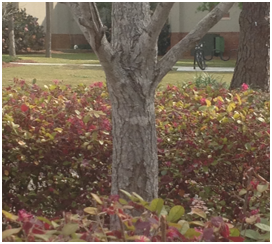Ginkgo
Ginkgo biloba
(Photo by Jessica Bartek)
View the Location on Campus
Taxonomy (1,2)
Classification: Gymnosperm
Family: Ginkgoaceae
Common name: Ginkgo, Maidenhair tree
General Information (1,3,4)
Region of Origin: Eastern China
USDA Plants Hardiness Zones: 3-8
Growth Habit: Tree
- Size: 120 feet
- Deciduous/Evergreen: Deciduous
- Cones: March-April
Diagnostic Characteristics
Leaves (2)
- Arrangement: Alternate
- Simple/Compound: Simple
- Shape: Fan
Stem/Bark (1)
- Color: Gray-brown
- Texture: Stringy, peeling, ridged and furrowed

(Photo by Nicole Rutledge)
Pollen Cone (1)
- Spirally arranged microsporangia
Seed Cone (2)
- Naked seed
- Color: Tan to orangeish
Horticultural Information (1,3)
- Light: Full sun
- Moisture: Moderate
- Soil type: Sandy
- Maintenance: Prune in spring
- Landscape Uses: Ornamental, street tree
Interesting Facts (3)
- The Gingko tree is the only living representative of the Ginkoaceae family
- The wood of the gingko is used as a base of lacquer ware and for abacus beads and other small articles
- It is advisable to plant male trees only due to the nauseating smell of female trees’ “fruits”
References
1) Dirr, M. (1998). Manual of woody landscape plants: Their identification, ornamental characteristics, culture, propagation and uses (5th ed.). Champaign, Ill.: Stipes Pub..
2) Scheper, Jack. (2012, March 23). Gingko biloba. Floridata. Retrieved April 1, 2013, from http://www.floridata.com/ref/G/gink_bil.cfm
3) Brickell, C., Cole, T. J. (. J., & American Horticultural Society. (2002). American Horticultural Society encyclopedia of plants and flowers (Rev. and updated. ed.). New York: DK Pub..
4) http://plants.usda.gov/plantguide/pdf/pg_ginkg.pdf
Edited by Jessica Bartek
Department of Biology
-
Room 2035, 2nd Floor
Bailey Science Building -
Mailing Address
1500 N. Patterson St.
Valdosta, GA 31698 - Phone: 229.333.5759
- Fax: 229.245.6585
Monday - Thursday
8:00AM until 5:30PM
Friday
8:00AM until 3:00PM
Saturday - Sunday
Office Closed